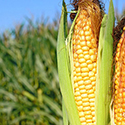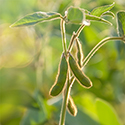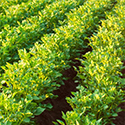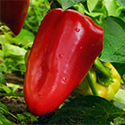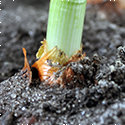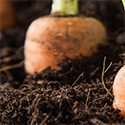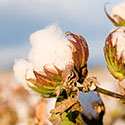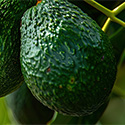Growing commercial blueberries
- The U.S. is the world’s leading producer of blueberries, 660 million lbs. in 2022
- Three commercially important species, highbush, lowbush and Rabbit Eye
- Commercial value is 100% food, 353.6 million lbs. sold fresh, 306.4 million lbs. processed
- A perennial, they must be pruned yearly in commercial production
- Available fresh in the U. S. year-round, fresh blueberries grown commercially are imported from Chile and Peru in Winter months
Growing Blueberries
- An optimal amount of chilling hours between 32° and 45°F are required to develop flower buds on dormant plants
- Plants require acidic soil at about 4.8pH. It can take several years to prepare soil.
- Two-year-old plants raised in greenhouses are planted for production
- Plants are usually transplanted while dormant
- Young plants fruits are often thinned for growth, 8-12 years to maturity is typical
- Many farms use overhead irrigation, which can be used to protect against frost
- Commercial best practice is to cool blueberries immediately following harvest to prolong shelf life
- Typical effective root zone is 18”
The Market for Blueberries
World production of commercially grown blueberries increased dramatically between 2020 and 2019, going from 439,000 metric tons to nearly 1 million metric tons. Nearly 40% of the increase came from production in the Southern Hemisphere, which made blueberries available year-round in many markets. Production increase was due in part to development of species that needed much less (or no) cooling time before flowering, allowing for production of blueberries in some warmer climates.
In United States, the majority of exports go to Canada, even though Canada is the second largest producer, this due to our differing growing seasons. The U.S. is a net importer of blueberries despite being the worlds biggest producer, exporting 83.6 million lbs. and importing 571.3 million lbs.
Agricultural Challenges When Growing Blueberries
Birds can be a major pest for fruit crops like blueberries. Netting is often employed during the growing season. While many species need a certain number of cool days just above frost level, hard frost is very detrimental to leaf growth and maturing fruit. For this reason, overhead irrigation is often employed in blueberry fields because it can be used to fight the effects of frost, although overall trickle irrigation is preferred.
There are several well-known diseases affecting blueberries; several fungi such as Mummy Berry, Twig Blight, and the ubiquitous Botrytis, as well as some viruses such as scorch and mosaic. Management can involve removing or burying diseased plants with cultivation or under mulch, careful pruning and proper drainage. Some diseases can only be managed by removal of plants or for some fungus use of fungicide.
Low bush and rabbit eye blueberries are fairly tolerant of drought, high bush is not. All of them prefer acidic soils. Blueberries do not do well in soils with pH over 5.5. In many agricultural areas the irrigation water can carry dissolved salts, which over time can alter the soil pH. Careful monitoring of soil electrical conductivity (EC) is very important when growing blueberries.
Contact AquaSpy
AquaSpy for Blueberries Grown Commercially
With a Crophesy annual subscription, you receive a free simple, three-, six- or twelve sensor, wireless, soil moisture probe. Pick the sensor depth based on your blueberry type and growing methods.
Then you can instantly monitor soil and crop health for all of your blueberries and other fruits. And if you want to test the soil in other areas, you can quickly and easily move the moisture probe, which is battery-powered and provides season-long insight.
While you can look at the visual analysis of leaves, spending hours in your field, Crophesy enables you to open your app from anywhere and show you what kind of nourishment is available in your soil at your blueberry plants root depth. With this data, you can determine when the active root zone needs vital nutrients.
In addition to nutrient data, the Crophesy app can show you:
- Moisture consumption at the root level
- Salinity level in the active root zone
- Root depth
- Soil temperature near the sensors
- Irrigation depth


